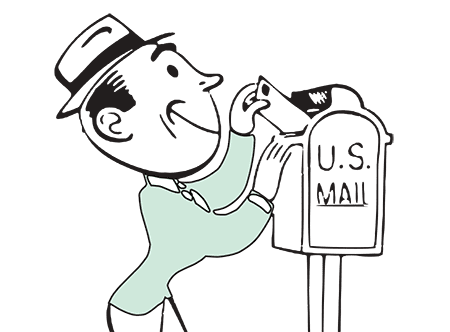You pay more for tailored Italian chinos than for cargo khakis. But wearing your chinos to the beach and your khakis to an interview wouldn’t be your smartest move. You’ve got to strategize how you wear them, and why. Direct mail is one of your most expensive marketing tools but can produce some of the highest returns on investment. But if there’s one key word for direct mail ROI, it’s strategy. It’s the how and why.
5 Ways to Raise Your Direct Mail ROI
As you’ve probably guessed, we’re not here to discuss ROI for trousers. We want you to get your very best direct mail ROI. But how does that work? Here are our 5 top-of-the-line tips.
1 – Locate the “likelies.”
Who are your “likelies,” people most likely to respond?
It’s often a good idea to send direct mail to people who already have a relationship with you, to encourage them to go deeper. This could be through a membership card or other customer loyalty program, a bigger commitment or additional purchase, or other ways to connect, such as new products or services, donations, catalogs, or signing up for an e-newsletter.
Sometimes, when you’re new to direct mail, you don’t yet know who you’re targeting, or you want to test the waters with a direct mail blast and use a regional or purchased mailing list.
But in most cases, you need to target. The more you can narrow down and pinpoint your audience, the better. Some factors include:
- Previous interactions with you / indications of interest
- Established relationship
- Gender
- Location
- Socioeconomic stats
- Spending habits/lifestyle preferences
2 – Have them at hello.
You don’t have to be Tom Cruise to know how to appeal. Direct mail, once opened, can pack a karate-kick impact for your ROI.
Personalization goes a long way to catch attention. Some easy ways to personalize include using the addressee’s name (and spelling it right!), and using second person pronouns like “you” and “we.”
Tap into your target profiles for personalized details you can use. A grocery delivery service, for example, might send an offer to parents for a hefty discount on delivery, an offer to students right before exam season, and discounted subscription to healthy meals-on-the-go to single-person households.
And always include a clear deadline for the targeted offer. This increases urgency and helps you follow tip 3 (below).
Color and design catch attention in the right way when it’s clear who you are and what your campaign is about. You don’t want visual noise. People tune that out. Create a strong, clean envelope design, a strong header, and copy that’s easy to browse for a clear offer and call to action. And don’t use a fake-out. Don’t exaggerate your offer, and don’t play “urgent” or “official” if your campaign is honestly neither.
3 – Don’t give away the store.
Make customers an offer only available through direct mail. Don’t offer them the same discount or opportunity you’re offering through your other channels. This reduces the supply and narrows the demand through one funnel, strengthening its appeal. It also makes your offer stand out, and makes ROI much easier to measure and track, if you connect a special promo code only to your direct mail campaign.
Your offer also needs to be big enough to be appealing, but not so large that you’re losing money or coming off as fake. “50% off first purchase” or “First 6 months of subscription free” is far more convincing than “FREE CAR!!” and far wiser than offering significant free services without asking for any contact or payment information.
Always include an easy way for a customer to connect with you, by phone, email, return card, or web landing page. If you create a unique number, address, tracking code, or URL for this particular offer, you’re not only giving away a helpful service without giving away the store; you’re also making your responses easy to track.
Make an offer, make it clear what your customer is getting out of it, and make it easy for yourself to know what you’re getting out of it, too.
4 – Reduce production cost.
Do your research and figure out ways to send your campaign frugally without losing out on value.
Interesting sizes and textures, inserts and return cards, colors and freebies—they can all add to the appeal and strategy of your direct mail piece. But your budget is definitely a factor in your ROI. So don’t forget to take into consideration:
- Non-profit mailing rates
- Bulk rates
- Postcards vs. letters
- Size and weight
- Discounts from production companies or other marketing partners
5 – Follow up.
Now, are you just going to leave your customers hanging? Of course not! ROI increases when customers receive follow-up.
One direct mail campaign is a single link in a chain to drive conversions. People love mail, so sending appropriate, personalized follow-up direct mail pieces can be an effective way to go. Repetition leads to increased awareness and keeps you top of mind. If a prospect isn’t interested now, he or she might be later. You can build credibility in the meantime.
Also, pay attention to when a customer responds to a direct mail piece but doesn’t purchase or commit. These folks can be retargeted through social media, follow-up email, web ads, and additional direct mail campaigns that pick up where the last campaign left off. You may even find it useful to track whether certain target groups tend to respond without purchasing or redeem an offer going further. This can give you information to add to target profiles and use for future campaigns.
Connecting direct mail to sales starts with the open envelope. For a customized campaign envelope at the right price, buzz us at Letter Jacket. We know how to get you started. Free shipping on your first order!



